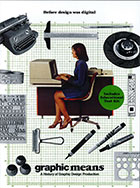
Graphic Means: A History of Graphic Design Production 2017
Distributed by Tugg, Inc., 855-321-8844
Produced by Briar Levit
Directed by Briar Levit
DVD, color and b&w, subtitles in English, Spanish, German, French, Russian and Japanese
High School - General Adult
Graphic Design, Print Industry, Desktop Publishing
Date Entered: 08/17/2018
Reviewed by Barbara J. Walter, Longmont Public Library, Longmont, CO…the biggest take-away I got from immersing myself in this era and thinking about the tools that designers used—is that they are, in fact, just tools. There was brilliant design before the computer, there has been brilliant design after, and there will continue to be brilliant design to come.
--Briar Levit, from interview with Khoi Vinh, subtraction.com 2/6/2017
Graphic Means outlines the history of pre-digital graphic design, examining in detail the tools and processes of the cold-type era, as well as the seismic shift in the field brought about by the emergence of digital technology.
Director-producer Briar Levit (Assistant Professor, Graphic Design, Portland State University; former art director, Bitch magazine) combines stills, clips from educational films, animated sequences and interviews of typesetters, designers and others active in the industry at the time, to give viewers an appreciation for the amazing complexity of the pre-digital design process. In addition, Levit brings out the human side of the story, explaining the working relationship between typesetters and designers, the atmosphere in design studios, and the experiences of women entering a previously male-dominated field.
Excellent in all technical elements, Graphic Means is a lively account of the history of graphic design before the desktop computer, and is a wise choice for academic libraries supporting programs in graphic design. It’s also a fine pick for public libraries—an absorbing, eye-opening film for young designers, print industry professionals, fans of Mad Men-era advertising, and general design enthusiasts.
The DVD is chaptered and includes a study guide with questions for discussion. Extras feature two exercises (Dry Transfer Logotype and Paste-up Newsletter) to give students a feel for pre-desktop-era graphic design, an interview with the film’s director, a glossary of graphic design terms used in the film, plus recommendations for further reading and viewing.